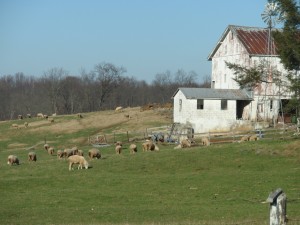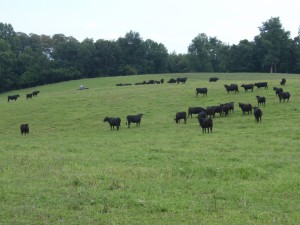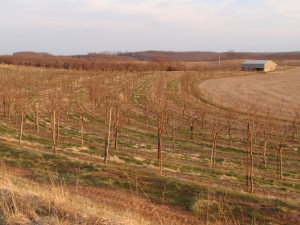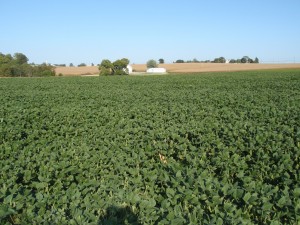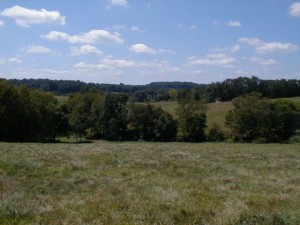Welcome to the Sept. 2010 edition of FPR. Scroll down to view all content, or, you can click on the link below for the printable version. The online version has slightly more content than the print version.
THREE MOVE UP IN NATION’S TOP 12 RANKING
BY DEBORAH BOWERS, Editor & Publisher
LANCASTER, PA – The nation’s leading locally-operated farmland preservation programs preserved 7,460 fewer acres and received $16.4 million fewer local dollars in the last 12 months than in the year prior, but all programs operating in those localities preserved 18,313 farm acres in the period, which began Sept. 15, 2009, according to an annual survey conducted by Farmland Preservation Report.
The 12 counties have preserved a total of 668,364 acres through all programs. Last year’s total figure was 649,898. The survey tallies agricultural acres preserved by easement by government-operated programs, land trusts and township programs.
The counties combined committed $73.9 million to purchase agricultural conservation easements over the 12-month period surveyed, and committed $57.5 million for the upcoming 12 months, according to administrators. The totals do not include state and federal dollars.
Three county-operated farmland preservation programs – Carroll and Baltimore in Md., and York in Pa.- moved up in a ranking of the nation’s Top 12 local programs conducted as part of the survey, and most programs in the Top 12 have money to spend on new projects despite local and state budget crunches. A few programs have new policies and regulations to aid their twin goals of preserving farmland and keeping agriculture a working industry.
Lancaster County, Pa. remains the top program in the nation, reaching a preserved-acre total of 85,510. The county-run program logged 2,378 acres since the last survey in Sept. 2009. Lancaster County’s preserved-acre total is helped by the nonprofit Lancaster Farmland Trust, which has preserved 20,253 acres, 1,024 of those acres in the last 12 months, according to LFT deputy director Jeff Swinehart.
Lancaster County will continue to lead the nation for a long time – it has a 15,000-acre lead over second-place Montgomery County, Md., which has reached its preservation “build-out.” Third-place Berks, at its current level of activity, will overtake Montgomery in three years.
Lancaster is a leader in policy and innovation as well as acres preserved. This year it increased the acreage required to achieve an agricultural subdivision on a preserved farm, and is now allowing renewable energy production for farm use only, according to Matt Knepper, executive director of the Lancaster County Agricultural Preserve Board. Also, the Ag Preserve Board approved a fee schedule for reviewing subdivision and rural enterprise proposals. The proposal was tabled by the state board, which will consider it again Oct. 6. The county holds more than 800 easements.
“The highest fee would be for a residential subdivision – building a house and subdividing,” Knepper said. “In those cases, we’re dealing with reviewing an official subdivision plan, corresponding with our county planning commission and other reviewing agencies, and making sure the local municipality isn’t requiring anything that will have a negative impact on the remainder of the farm,” he said.
According to Doug Wolfgang, director of the Pa. state program, Lancaster is the first to seek fees for review of subdivision plans. He said counties have the authority to set fees and he expects other counties might consider fees as well.
Carroll and Baltimore Counties in Md., and York County, Pa. moved up in the ranking from their 2009 spots. Carroll moved from 5th to 4th place, overtaking Chester County, Pa. Baltimore County moved from 7th to 6th place, overtaking Burlington County, NJ, and York moved from 9th to 8th place, overtaking Harford County, Md.
Carroll County, Md. has the strongest showing in acres preserved in one year and in funds committed of all counties in the survey.
All counties in the survey except for Carroll and Burlington show fewer new acres, often dramatically fewer acres, than last year. For example, Frederick County in the Sept. 2009 survey had preserved 3,704 acres in the preceding 12 months, but in this year’s count had preserved just 650. The local allocation for the Frederick program had dropped too, from $6.9 million to $3.8 million.
Carroll County is set to rise in the ranking like Berks County did after a bond issue of $30 million pushed Berks from 11th place in 2000 to 3rd place in 2007.
Last year Carroll County Commissioners, eager to make good on a promise to preserve agriculture the same year a move toward more restrictive zoning failed, handed the program nearly $19 million. When that kind of money is combined with innovative finance, the result will likely be notable: in the last 12 months, the Carroll program, headed by Jeff Everett and Ralph Robertson, logged 4,178 acres, nearly twice that of Lancaster County, which logged the second highest tally of 2,378 acres.
Carroll County activity is aided by eager landowners who feel the competition and are willing to discount their principal in the county’s installment program in exchange for higher interest payments, an arrangement set up by Everett. The county is on track to save big dollars due to the innovation.
Carroll is also on track to move up in the ranking again, even though Berks County, Pa., in 3rd place, has preserved 8,262 more acres. If Carroll keeps up its 4,000-acre per year pace, it will overtake Berks County in 2014.
Carroll County’s preservation map can be viewed at http://ccgovernment.carr.org/ccg/agpres/mapping.asp.
Next door, Baltimore County logged just 160 acres in state and county ag land preservation programs, but activity was boosted by land trust action through the Rural Legacy Program and donations to the Maryland Environmental Trust. That activity provided a gain of 2,619 acres, and gave the boost over Burlington County, NJ, where “other program” acres sat still over the last 12 months. Other acres for Burlington come from the Pinelands Development Credit Bank, which depends on demand for transferrable development credits. There was no reported acreage gain in the period.
Baltimore County contains five Rural Legacy Areas (RLAs), four administered by land trusts. It draws the most money from the state RLP of any county as a result. The Piney Run RLA in western Baltimore County is the most active in the state.
York has overtaken Harford County, Md., by preserving 714 acres in its farmland program while the Harford program stood still in 2010. York’s standing was helped by the Farm and Natural Lands Trust of York County, which preserved 779 acres since last fall, according to director Sean Kenny.
In York, where development pressure from Harford and Baltimore Counties in Maryland has eaten away at the Piedmont countryside over the last 40 years, 240 farms and 37,654 acres are preserved to date. Recently local money committed to the program has dropped dramatically, however, to $100,000 last year and $200,000 this year. Administrator Patty McCandless says the program will receive $841,000 from the state and about $323,000 in federal FRPP funds. Those funds will boost the low county dollars and keep York in a position to gain more ground over Harford, which has zero dollars to spend on new easements for the forseeable future.
Harford County’s program was once the hottest in the ranking, but the local program was set up to buy easements with installment purchase agreements (IPAs) and to run only on revenues from a local transfer tax. Those revenues are dramatically affected by washed up home sales, and local officials have no plans to borrow money to save farmland, even at bargain prices. That leaves Harford’s once innovative and punchy program in the doldrums. It is the only program of the Top 12 without any funding for new purchases.
Billy Boniface, president of the Harford County Council, said he worries that Maryland’s deficit will affect counties even more than it has already, with cutbacks on local school construction dollars and road maintenance.
“My concerns are, it’s very difficult to go off into the bond market in addition to the IPA payments, without another funding source.”
Harford’s installment purchases, which began in 1993, pay out interest annually. The transfer tax is bringing in about $2 million – just enough to make the payments on existing IPA purchases. For the third year, Harford will not open an application round. There was only one state-purchased easement in the last 12 months, on a 82-acre farm. Other activity will be through a $1.3 million grant to the Deer Creek Rural Legacy Area from the state’s Rural Legacy Program, most, if not all of which will be spent on agricultural lands, but only within the RLA. In 2009, Harford’s ag program gain came from settlements of the program’s last, and largest offer round in 2008.
In Chester County, 6,027 acres have been preserved through local county and township cooperative programs and 21,158 acres through the state program for a total of 27,185 ag program acres. The Brandywine Conservancy has preserved 31,530 acres of agricultural lands according to assistant planner Melissa Burke. The conservancy holds easements on 43,000 acres total in Chester County and in Delaware. The Conservancy spends a good deal of time helping area farmers apply for Chester’s farmland preservation program and has worked with Amish and Plain Sect farmers through special grants, Burke said. The organization also assists municipalities with planning and preservation priorities, and works with them on jointly-funded easement projects.
Chester’s notable ag economy based on mushroom production increased in value from $376.7 million in 2002 to $553.2 million in 2007 according to the USDA 2007 Census of Agriculture (see sidebar story on other Census of Agriculture changes).
Second place Montgomery County is in a place all its own: it has reached its preservation goal and is now focusing on making preservation more restrictive by removing some of the 1:25 density left behind by its TDR program. Legislative and regulatory action that will now enable the county’s new Building Lot Termination (BLT) program to begin, precluded settling new easements over the last year. One farm was preserved under former regulations. According to administrator John Zawitoski, the BLT will start up in November.
“We have lots of interest in farmland preservation, more so than I can remember in recent years. I am sure it’s a function of the economy and fortunately we have some funding and a new program to offer to landowners.”
Montgomery’s $7 million funding comes from $2 million in general allocations on hand as well as $5 million for the new BLT program. The County Council also authorized $2 million in bond money for both FY 2011 and FY 2012, but the program will have to make a case for those funds, competing with other needs. The bond authorization is not included in the accompanying table.
Marin County’s agricultural lands are being preserved by the Marin Agricultural Land Trust, the only program in the Top 12 ranking that is operated entirely by a land trust. The organization is funded through contributions from the community and this year preserved 375 acres and has about $4 million to work with. Over the next 12 months, MALT is poised to preserve 2,000 to 3,000 acres, according to director Bob Berner. MALT is just a few hundred acres behind 10th place Frederick County, Md., and could easily gain that spot if the projected increase is reached. A map of preserved lands in Marin can be viewed at http://www.malt.org/about/map.php.
The Sonoma County Open Space District did not report new acreage or funding figures prior to deadline. Those given in the table are from last year.
Click on the link at the top of the page to download the print version of this newsletter. The print version does not contain all the content of the digital version.
Census of Agriculture released in 2009 affects tallies in Top 12 survey
The USDA 2007 Census of Agriculture, released in 2009, made changes in how land in farms is measured. The USDA farmland figures included both actual land in farms and potential farmland. These changes are reflected in the annual survey of leading farmland preservation programs conducted this month by Farmland Preservation Report, according to its editors.
The 2007 ag census created some quirks in the 2010 FPR survey, according to publisher Deborah Bowers. For example, Montgomery County, Md. now has more acres preserved than it has land in farms, and the 2007 census also shows Lancaster County with 13,488 more acres of farmland than it had in 2002.
Comparing the census’ 2002 and 2007 figures, the FPR survey showed a decrease in land in farms of 119,052 acres in the 12 leading farmland preservation counties combined. This decrease resulted in a significantly higher average among those counties for the percentage of land in farms preserved, from an average of 25.5 percent to an average of 41 percent.
The market value of agricultural products for the 12 counties in the survey increased from $2.6 billion to $3.2 billion from 2002 to 2007 in the ag census. All counties in the ranking saw notable increases in market value except for Montgomery County, which saw a drop from $41.6 million to $33.1 million.
PA program administrators to automate project proposals
HARRISBURG PA – Farmland preservation administrators at the county level in Pa. will be learning how to send their project proposals to the state using a new automated system created in-house that will make a lot of the paperwork involved in an easement project a thing of the past, according to state director Doug Wolfgang. The new system will be demonstrated following a state board meeting Oct. 6.
“It will just be an introduction of it at this point, we’re not ready to go live, but at least we have something we can experiment with and get the counties to test,” Wolfgang said. “We’re hoping to go live with it sometime in early 2011.”
The department has been working on the system for about 3 years. It is “a program to automate submission of county easement recommendations at the county level,” he said. “Typically, now, when we get an easement recommendation, there’s a whole lot of paperwork associated with it and then a whole lot of paperwork that goes to the state board.. so what we’ve done is create, through our own IT Department, a web-based program where counties can upload a lot of that information.”
Another important feature, he said, is the system will enable the state and counties to share information about easement properties such as changes in ownership.
Some documents such as agreements of sale will still have to follow in hard copy, but county administrators will be able to upload title commitments and maps and other documents, and project summaries will have a standard format. The state board will be able to review the documents online.
“We’re really looking forward to it. It will eliminate some of the paper pushing, and there will be a cost savings with postage and copies,” Wolfgang said.
Thinking Big Is One Thing – Doing Big Things Is Another!
BY MIKE MCGRATH, Contributing Editor
In previous articles I’ve suggested that our farmland preservation programs need to set bigger goals. It’s time to push our agenda to provide real, serious critical mass for the agricultural industry, for food supply and the provision of environmental amenities. I suggested that those of us on the front lines of land preservation should press for the protection, permanently, of 60% – 80% of the farm land in our jurisdictions.
We should be bolder in the demands we make for financing. And you may say, “Sure, Mike, it’s all well and good to talk that way – but how do we get there?” You’re right – we need some practical steps in order to move this “bigger” agenda. Let me try to give you a couple of ideas that have worked well for me.
First, know the agricultural industry in your jurisdiction and the roles it plays in the local economy. For some reason that I still don’t understand completely, political leaders in this country, at all levels, remain fixated on jobs – and we can use that to press for preservation. We need to study the agricultural economy and the many ways it impacts our lives. I have tried to constantly collect data on the food system industries in Delaware; everything from the farm suppliers all the way out to the food stores; and everything in between. As land preservationists we must be able to make a strong case for the economic importance of the land and tie this to the food system. Leaders and citizens are much more attuned today to the food system, food security and the local economy. When taken as a whole we can make a strong case for the economic importance of the food system and the crucial role of land preservation.
Agriculture, horticulture and forestry are especially important in providing for the employment of workers who often would have difficulty in finding work otherwise. In Delaware this has been a key factor in keeping overall unemployment low. In addition, having a stable land base retains and attracts new ag suppliers as well as buyers and processors. In the recent economic downturn agriculture has remained a bright spot in the U.S. economy. We can capitalize on that now as we argue for the serious money we need for ag preservation. Keep these facts in front of key decision makers and pound home the economic importance of agriculture and its stabilizing influence in your local economy.
Second, make sure you are prepared to “gear up” for a bigger program and have the system in place that proves you are competent and efficient. Let me be blunt – if your program takes months, or years (!) to process and close preservation deals – why would farmers, citizens and legislators be eager to grow your program? If it’s a struggle to close the ten deals a year now, what are the prospects for doing a hundred a year?
As program administrators I believe we must be diligent in making our programs efficient while being careful to spend money according to the regulations and laws. We have been able to do just that in Delaware by using outside contractors for much of what we do. We hire outside lawyers, appraisers, GIS consultants and our monitoring staff. Only a small number of public employees manage our program. This means we have remained responsive, timely and flexible as we deal with changing numbers through the years. I recommend this approach. And another big part of this is making sure that there are lots of farms waiting to be preserved. Get them lined up and ready to go! And we need to motivate those owners to press for a bigger program and more funding. It sounds self-serving, but I’ve found in Delaware that the owners waiting to be funded can be the most eloquent and effective lobbyists!
Finally, we need to document the public’s solid support for farmland preservation and their willingness to pay. Over the years my office helped sponsor research by the University of Delaware in polling the support for farmland preservation. Other studies documented the willingness to pay for preservation and the farmland features (food, environmental amenities, rural culture, etc.) which citizens valued most.
Without a doubt I believe these studies, and communicating the findings to legislators, were the single most important factor in Delaware’s number one position in per capita funding for ag preservation. Politicians want to know how their constituents feel on issues, but often don’t get believable information. As Mark Twain once quipped, “The essence of politics is to find a parade and jump in front of it!” If we can show our leaders – clearly and factually – that a parade is forming behind farmland preservation – they will jump in front of it!
Even in tough economic times there are compelling reasons to “grow” our farmland preservation efforts. You will need to put together a solid portfolio of data, a track record and public support if you are to carry out a campaign for a larger ag preservation program. In a coming article I want to lay out some the fiscal reasons why now is the time to increase our preservation funding (yes, there are some sound public finance reasons that now is the time!).
In the meantime, start pulling together some of your local economic data, a plan to streamline your procedures (and get more clients) and collect some data on the public’s support for what we love to do – preserve more farms!
Mike McGrath is a contributing editor to Farmland Preservation Report. He is the director of the Delaware Agricultural Lands Preservation Foundation.
MD Rural Legacy Program awards $12.6 million
ANNAPOLIS, MD – The Md. Board of Public Works approved $12.6 million in grants Sept. 1 to 15 Rural Legacy Program sponsors, including local governments, land trusts and partnerships of the two throughout the state. The grants are used to purchase conservation easements on farm and natural lands in Rural Legacy Areas delineated by the grantees and approved by the state.
The grants were announced at a meeting where final data for fiscal year 2010 was released showing a general fund surplus. Gov. Martin O’Malley, one of three members of the Board of Public Works, stated that Maryland was positioned to lead the nation in coming out of the recession.
But state comptroller Peter Franchot warned that despite revenue exceeding what was forecast for 2010, funds were still short 3.7 percent when figuring in recent appropriations, and that revenues would have to increase by 14 percent four years in a row to regain pre-recession levels.
Natural Resources Secretary John Griffin introduced the 15 Rural Legacy Program funding proposals, most of which equaled or exceeded $1 million.
While listening to the proposals, Gov. O’Malley stated his interest in seeing lands preserved despite tough economic times. He also stated his interest in seeing legislation that will eliminate the Maryland estate tax on farms. He said it wasn’t right “that farmers have to sell part of their farm to pay the estate tax.” A bill to eliminate the Md. estate tax for preserved lands was heard in committee in the 2010 legislative session but was not passed.
The Md. Board of Public works is made up of the governor, state comptroller and state treasurer. All three voted to approve the Rural Legacy grants.
O’Malley, a Democrat who is running for reelection this fall, pledged when he took office in Jan. 2007 that he would fund land preservation each year regardless of the slowdown in revenues from the real estate transfer tax that was already occurring. The state’s farmland preservation program as well as the Rural Legacy Program are currently funded with bond money.
Two land trusts in Baltimore County, the Land Preservation Trust and The Manor Conservancy, both of which focus on agricultural lands, each received grants of $1 million to purchase easements in their respective Rural Legacy Areas. The Eastern Shore Land Conservancy received $500,000; Carroll County, which also focuses on agricultural lands, received $1 million and Harford County received $1.36 million, the largest of the grants. Frederick County also was awarded a $1 million grant. Carroll, Harford, Frederick and Baltimore counties rank in the nation’s top 12 locally operated farmland programs.
The farm, after the deal
BY TOM DANIELS, Senior Contributing Editor
Farmland preservationists are often asked, “Is your purpose to preserve land or to preserve the farmers who work the land?” Ideally, it’s both. Land preservation is often the easier goal, though maintaining adequate funding from public and private sources poses a long-term challenge. Keeping farmers on the land, however, is a lot trickier.
Studies have shown that most farmers invest the money they receive for selling their development rights back into their farming operations. Yet, the PDR payment is a one-shot deal. So farmers must use the money carefully as part of a long-term business plan.
Agriculture is a dynamic industry and will continue to change over time. There are several ways that local governments together with consumers can help farmers earn a decent living on their preserved land. As part of the farmland preservation deal, the deed of easement can allow a variety of agricultural-related uses on the farm. One example is a bed and breakfast operation. Another is a farm stand for direct sales of farm produce to consumers. Yet another is to allow new agricultural enterprises or buildings, such as a winery. Keep in mind that local zoning must allow these uses or buildings.
Wind turbines, solar farms and cell phone towers are more controversial. Are they non-farm commercial operations not permitted under the deed of easement or are they ancillary uses? And are they compatible with conservation values? Again local zoning plays an important role. Local elected officials will likely struggle, as they did recently in Lancaster County, over the question of whether using farm fields for solar panels poses a threat to traditional agriculture and whether it is an acceptable use in an agricultural zone.
Local governments can support farmers by setting up farmers markets, and many have done so over the last 10-15 years. There are now more than 6,000 farmers markets nationwide, according to the USDA Agricultural Marketing Service. In 2000 the AMS found just 2,863.
Changes in federal farm programs are difficult to predict, yet they can have huge effects on the profitability of farming a preserved farm.
In recent years, “preserving the farmer” has caused some to forget that the original purpose of farmland preservation was to keep farmland available for future generations and that is still the driving force of PDR programs in both the legal and pragmatic sense. A farmer who can’t earn a decent living on a preserved farm can put the farm up for sale. The new owners can try their hand at farming or maintain the property as open space until economic conditions change to make farming the property attractive again.
As tens of millions of acres of farmland change hands over the next 20 years, what the new owners decide to do with it will have major consequences for communities all across America. Preservation programs can ensure that at least some of that land stays farmland, and can help the new owners stay on the land. But governments, land trusts, and consumers will all play important roles in preserving farmland and making it profitable to farm.
Tom Daniels teaches planning and land preservation at the University of Pennsylvania. He is author of “When City and Country Collide.”
FarmFest to be held at controversial dairy farm in MD
GLEN ARM, MD – A Baltimore County preserved farm whose proposed retail creamery business caused neighbors to protest such uses on preserved farms will be the site, Oct. 2, of a local food festival sponsored by 1000 Friends of Maryland. The $25 ticket sales will support the organization’s Keep Farmers Farming program, according to project director Kelly Carneal.
A Baltimore County circuit court judge ruled in March 2009 that neighbors had no standing to oppose the Maryland Agricultural Land Preservation Foundation’s approval of the creamery plans. The Prigel family sold the development rights on their 180-acre farm to MALPF in 1996.
FarmFest will include a bluegrass and acoustic guitar musical venue beginning at noon Oct. 2. A number of local producers including a winery will be serving their products. For more information see http://friendsofmd.org/farm-fest.
Conferences
Oct. 7-9, Doylestown, PA: Precarious Alliance Sustainability Symposium, held at Delaware Valley College. See www.precariousalliance.org
Oct. 27 – 30, Austin, TX: National Preservation Conference of the National Trust for Historic Preservation. “Join hundreds of grass-roots volunteers, skilled professionals, and preservation experts exploring preservation today—in urban and rural settings across the United States.” See http://www.preservationnation.org/resources/training/npc/.
Nov. 1-3, Fairlee, VT: Women in Sustainable Agriculture conference. See http://www.uvm.edu/wagn/?Page=conference/index.html&SM=conference/sub-menu.html.
Nov. 11 – 13, Albany, NY: It Takes A Region 2010 ~ A Working Conference to Build Our Northeast Food System, the conference of the Northeast Sustainable Agriculture Working Group. Registration thru Oct. 22 @ $140, after $180; includes meals. See http://www.ittakesaregion.org/background.html.
Nov. 23, Allentown, PA: Intensive Training in Organic Vegetable Production for Educators & Service Providers, sponsored by PennState Cooperative Extension at the Lehigh County Ag Center. Contact Tianna DuPont at attdupont@psu.edu.
Feb. 3-5, 2011, State College, PA: Farming for the Future, annual conference of the Pa. Association for Sustainable Agriculture. See http://www.pasafarming.org/our-work/farming-for-the-future-conference.
May 19-21, 2011, Harrisburg, PA: Pennsylvania Land Conservation Conference, sponsored by Pa. Land Trust Assn. Proposals due by Nov. 1. See http://conserveland.org/conferences/10/request_for_proposals.
